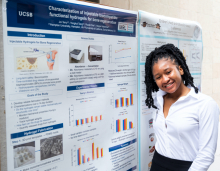
Major:
University:
Mentor(s):
Faculty Sponsor(s):
Faculty Sponsor's Department(s):
Project Title:
Project Description:
Bone losses are associated with degenerative diseases, fractures related to osteoporosis, load-bearing implants inside the body. More than millions of bone loss-related therapeutic interventions are performed annually in the United States. One non-surgical method to prevent bone loss is inhibiting osteoclast (bone-eating cells) activity by administering anti-resorptive agents typified by bisphosphonates (BPs). BPs actively bind with hydroxyapatite crystals within the bone and are subsequently released and uptaken by osteoclasts, reducing their activity. BPs are currently used clinically to treat osteoporosis, metabolic bone diseases, and metastatic bone tumors and have also been found useful in preventing bone loss surrounding the implants. Presently, BPs are not administered directly to treatment sites but are given in high doses intravenously or orally to achieve the desired effect. This often leads to severe side effects. To prevent these abnormalities, new approaches are needed to enable local and sustained delivery of BPs with minimal systemic distribution through direct injection into the bone loss site.
In regenerative medicine applications, injectable hydrogels have shown promising results as a delivery vehicle. Owing to its biocompatibility, high tissue-like water content, ease of encapsulating cells, drugs, growth factors, and simplicity of manipulating its physical properties, they exhibit great potential in integration studies to the bone matrix by incorporating osteoinductive material like hydroxyapatite (HA) along with Zoledronic acid (ZA), type of BPs. HA and ZA are clinically proven to aid bone formation and treat or prevent bone diseases such as osteoporosis. Despite the attractive properties of injectable hydrogel scaffold for many applications in drug and cell delivery, the combined use of a hydrogel scaffold encapsulating ZA coated on HA nanoparticles to provide a time-controlled release of bioactive drugs and form a new bone tissue simultaneously have not been explored much. Before such materials can be applied in animal models or humans, it is essential to understand their mechanical properties and abilities to release the HA and ZA components over time. In this study, utilizing a commercially available biocompatible hydrogel kit (Advanced BioMatrix HyStem-HP), we fabricate two groups of hydrogels: (1) pure hydrogels and (2) hydrogels with ZA-coated HA nanoparticles (HA NPs). Throughout a 14-day duration, we characterize their Young’s modulus, a measure of elasticity, through indentation tests and track the amount of ZA and HA released from the second group of hydrogels through UV-Visible spectroscopy and colorimetric analysis, respectively. Our results will guide material design and fabrication, and will inform future biomedical applications.
